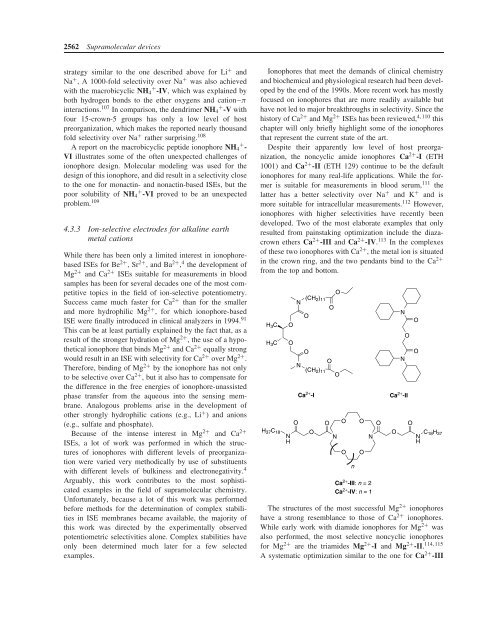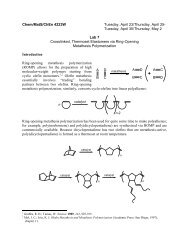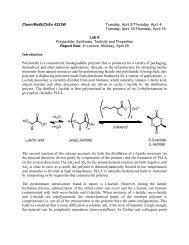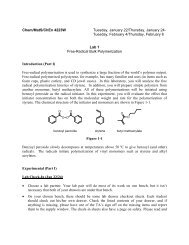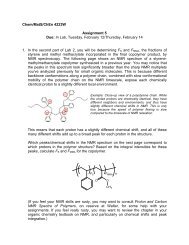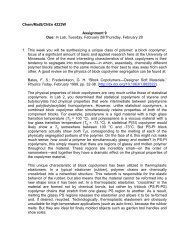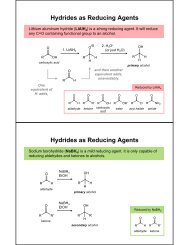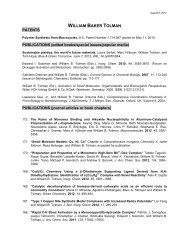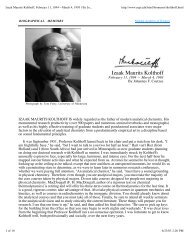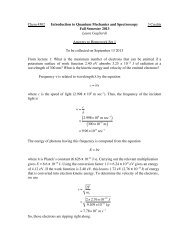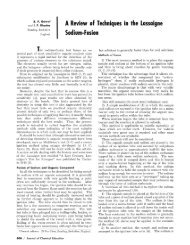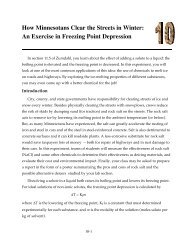Ion-Selective Electrodes With Ionophore-Doped Sensing Membranes
Ion-Selective Electrodes With Ionophore-Doped Sensing Membranes
Ion-Selective Electrodes With Ionophore-Doped Sensing Membranes
You also want an ePaper? Increase the reach of your titles
YUMPU automatically turns print PDFs into web optimized ePapers that Google loves.
2562 Supramolecular devices<br />
strategy similar to the one described above for Li + and<br />
Na + , A 1000-fold selectivity over Na + was also achieved<br />
with the macrobicyclic NH 4 + -IV, which was explained by<br />
both hydrogen bonds to the ether oxygens and cation–π<br />
interactions. 107 In comparison, the dendrimer NH 4 + -V with<br />
four 15-crown-5 groups has only a low level of host<br />
preorganization, which makes the reported nearly thousand<br />
fold selectivity over Na + rather surprising. 108<br />
A report on the macrobicyclic peptide ionophore NH 4 + -<br />
VI illustrates some of the often unexpected challenges of<br />
ionophore design. Molecular modeling was used for the<br />
design of this ionophore, and did result in a selectivity close<br />
to the one for monactin- and nonactin-based ISEs, but the<br />
poor solubility of NH 4 + -VI proved to be an unexpected<br />
problem. 109<br />
4.3.3 <strong>Ion</strong>-selective electrodes for alkaline earth<br />
metal cations<br />
While there has been only a limited interest in ionophorebased<br />
ISEs for Be 2+ ,Sr 2+ ,andBa 2+ , 4 the development of<br />
Mg 2+ and Ca 2+ ISEs suitable for measurements in blood<br />
samples has been for several decades one of the most competitive<br />
topics in the field of ion-selective potentiometry.<br />
Success came much faster for Ca 2+ than for the smaller<br />
and more hydrophilic Mg 2+ , for which ionophore-based<br />
ISE were finally introduced in clinical analyzers in 1994. 91<br />
This can be at least partially explained by the fact that, as a<br />
result of the stronger hydration of Mg 2+ , the use of a hypothetical<br />
ionophore that binds Mg 2+ and Ca 2+ equally strong<br />
would result in an ISE with selectivity for Ca 2+ over Mg 2+ .<br />
Therefore, binding of Mg 2+ by the ionophore has not only<br />
to be selective over Ca 2+ , but it also has to compensate for<br />
the difference in the free energies of ionophore-unassisted<br />
phase transfer from the aqueous into the sensing membrane.<br />
Analogous problems arise in the development of<br />
other strongly hydrophilic cations (e.g., Li + ) and anions<br />
(e.g., sulfate and phosphate).<br />
Because of the intense interest in Mg 2+ and Ca 2+<br />
ISEs, a lot of work was performed in which the structures<br />
of ionophores with different levels of preorganization<br />
were varied very methodically by use of substituents<br />
with different levels of bulkiness and electronegativity. 4<br />
Arguably, this work contributes to the most sophisticated<br />
examples in the field of supramolecular chemistry.<br />
Unfortunately, because a lot of this work was performed<br />
before methods for the determination of complex stabilities<br />
in ISE membranes became available, the majority of<br />
this work was directed by the experimentally observed<br />
potentiometric selectivities alone. Complex stabilities have<br />
only been determined much later for a few selected<br />
examples.<br />
<strong>Ion</strong>ophores that meet the demands of clinical chemistry<br />
and biochemical and physiological research had been developed<br />
by the end of the 1990s. More recent work has mostly<br />
focused on ionophores that are more readily available but<br />
have not led to major breakthroughs in selectivity. Since the<br />
history of Ca 2+ and Mg 2+ ISEs has been reviewed, 4, 110 this<br />
chapter will only briefly highlight some of the ionophores<br />
that represent the current state of the art.<br />
Despite their apparently low level of host preorganization,<br />
the noncyclic amide ionophores Ca 2+ -I (ETH<br />
1001) and Ca 2+ -II (ETH 129) continue to be the default<br />
ionophores for many real-life applications. While the former<br />
is suitable for measurements in blood serum, 111 the<br />
latter has a better selectivity over Na + and K + and is<br />
more suitable for intracellular measurements. 112 However,<br />
ionophores with higher selectivities have recently been<br />
developed. Two of the most elaborate examples that only<br />
resulted from painstaking optimization include the diazacrown<br />
ethers Ca 2+ -III and Ca 2+ -IV. 113 In the complexes<br />
of these two ionophores with Ca 2+ , the metal ion is situated<br />
in the crown ring, and the two pendants bind to the Ca 2+<br />
from the top and bottom.<br />
H 3 C<br />
H 3 C<br />
H 37 C 18<br />
O<br />
N<br />
(CH 2 ) 11<br />
O<br />
O<br />
O<br />
O<br />
N (CH2 ) 11<br />
O<br />
N<br />
H<br />
O<br />
Ca 2+ -I<br />
O<br />
O<br />
O O O O<br />
O<br />
N<br />
N<br />
O O<br />
n<br />
Ca 2+ -III: n = 2<br />
Ca 2+ -IV: n = 1<br />
N<br />
N<br />
O<br />
Ca 2+ -II<br />
O<br />
O<br />
O<br />
O<br />
N<br />
H<br />
C 18 H 37<br />
The structures of the most successful Mg 2+ ionophores<br />
have a strong resemblance to those of Ca 2+ ionophores.<br />
While early work with diamide ionophores for Mg 2+ was<br />
also performed, the most selective noncyclic ionophores<br />
for Mg 2+ are the triamides Mg 2+ -I and Mg 2+ 114, 115<br />
-II.<br />
A systematic optimization similar to the one for Ca 2+ -III


